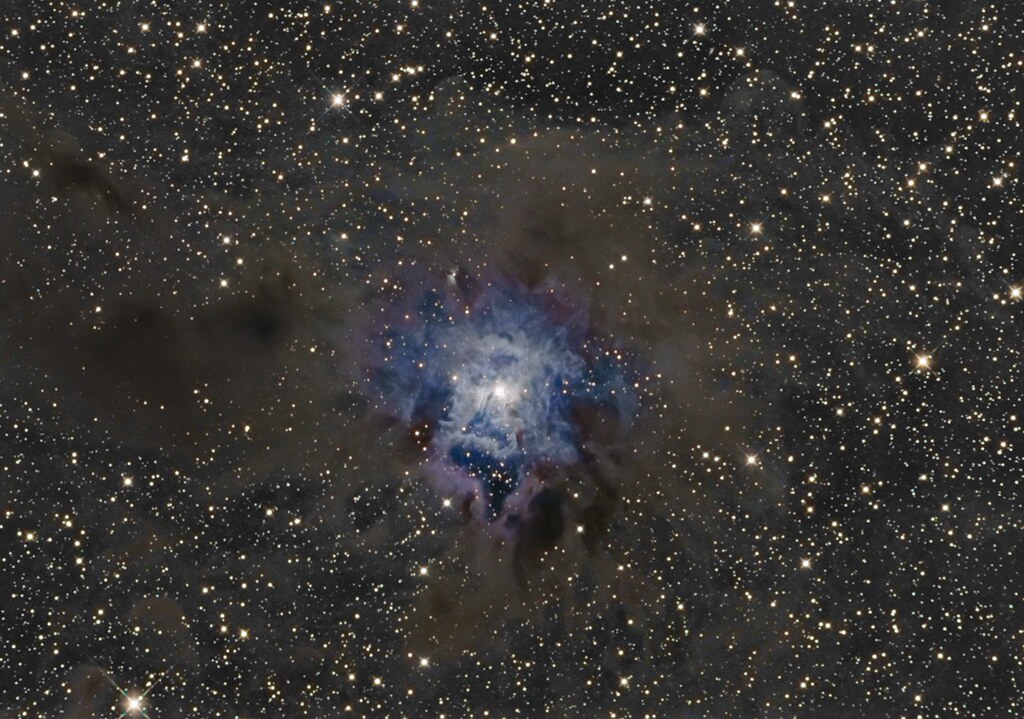On May 20th I started what would be this image. My first full-narrowband multi-panel mosaic began with the Pelican's head of the Pelican Nebula in Hydrogen-alpha. When I started imaging that night, I did not PLAN to be doing this mosaic. I just wanted to image the Pelican Nebula. As the evening went on and the sub-exposures stacked up I began thinking: I wasn't even getting the whole Pelican in this image and with my current setup this is as wide-field as I can get using the ccd camera - why don't I do a mosaic. I went in and began doing the calculations. For the field of view I was considering it would be around 18 panels, give or take, depending on just how far I wanted to extend it. Keep in mind that to do a full-narrowband image that would mean doing this mosaic 3 times over (note: after the Ha was completed I came up with an alternate way to do the SII & OIII - more on that later). On top of this, I am currently living in England. A country not exactly known for clear skies and in the summer there are very few hours of darkness due to the high latitude. Oh well! I might as well make this an extended project and off I went. I declared my intentions on the two astronomy forums I frequent just in case I began to let the enormity of this venture get the better of me they could keep me going. As luck would have it, and much to my surprise, I ended up getting quite a string of clear nights so was able to make relatively quick work of most of the Ha layer. Then things stalled for a while, mainly due to lots and lots of rain and clouds. It took me from May until August to finish up the Ha layer, which ended up being 18 panels just as I planned (17 completed it, but one was really noisy due to bad seeing and I didn't like how it merged with those around it so I did an additional one that overlapped part of the area and the surrounding panels).
I now had to do this all over again twice more ... or did I? I realized that the way I was planning on processing this meant that I would be using the Hydrogen-Alpha layer for all the detail and just needed the color-data from the OIII & SII as I was going to do a tone-map of all 3 for the colors. I had seen on my UK forum an adapter that allowed me to connect my Nikon lenses to my Atik ccd. I began to think this might just work and would cut down months on the total time I needed. I ordered the adapter and figured up the field of view requirement to determine which lens I needed with my small-chip ccd. Turns out that my 105mm Nikon lens would be perfect. I still wasn't convinced that it would work so once the adapter came in I spent a night doing a proof-of-concept with the OIII filter. I got a nights worth of data and came in to process a bicolor image to see if my plan would work. Voila! It DID! So instead of doing the 18 panels an additional 2 times I just needed a few clear nights each for the OIII & SII and would get the whole frame in each sub.
More rain, and a full moon delayed another week, but I was able to get around 7 hrs for each channel and went to process it to see if I would require more. I have determined I do not - that what I got would work well although normally the OIII & SII colors would still be a bit noisy at this point, since I was doing a tone-map that really didn't matter. So, at my 2 year anniversary of starting astrophotography my narrowband mosaic of the North American and Pelican Nebulas is complete. I have mapped the color in a modified Hubble Palette.
Here are the image details:
|
As soon as they finish uploading, the image will be available on my website under the Nebula section and a Zoomable to 1:1 version so you can see more details is located HERE. Currently only the Ha channel is located on the links. I will update this once the uploads are complete.




